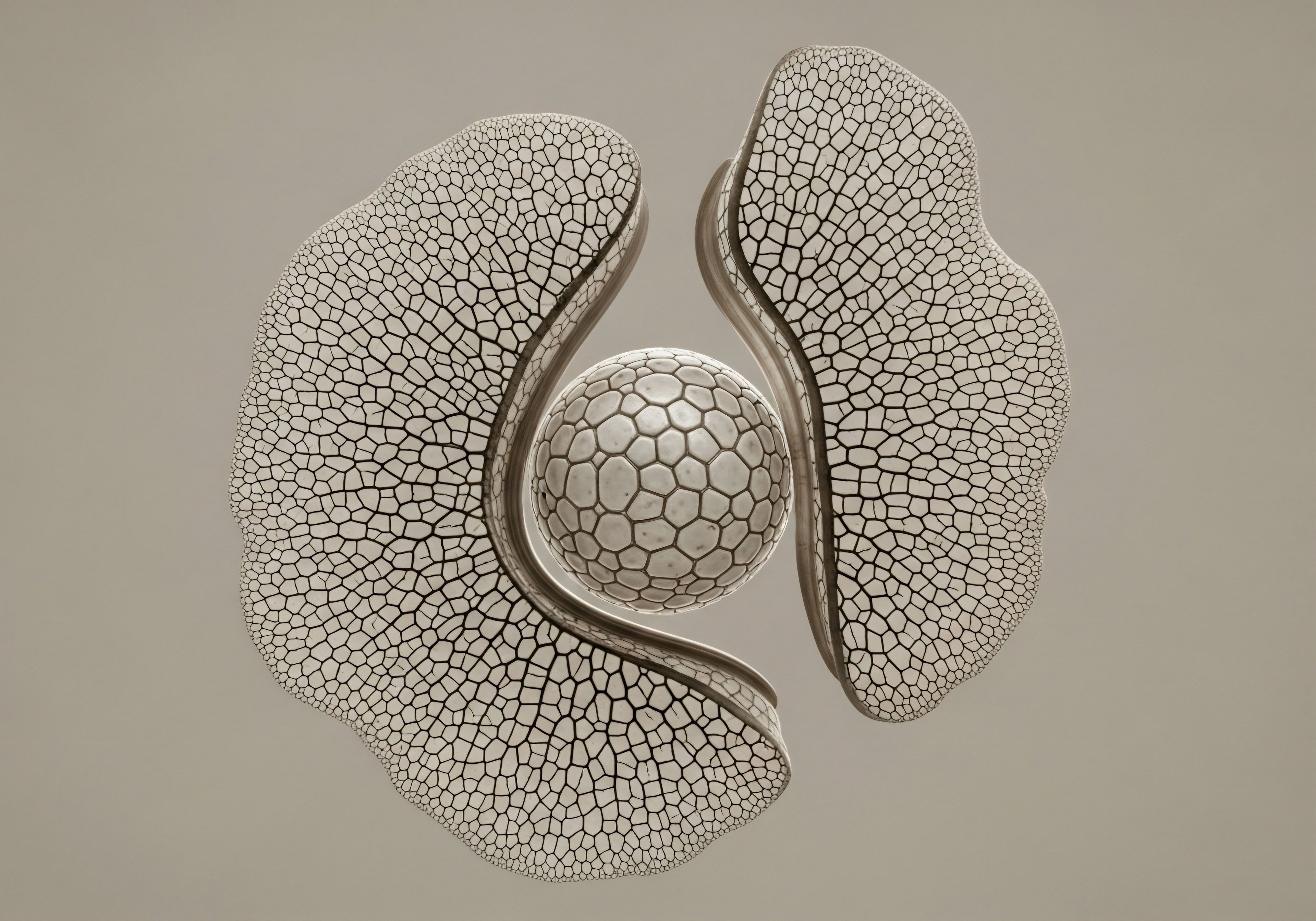

Fundamentals
You feel it as a persistent state of being stuck. It manifests as a weariness that sleep does not resolve, a frustrating layer of abdominal fat that resists diet and exercise, and a mental fog that clouds focus and drive. This experience, this lived reality for so many, is where the clinical conversation must begin.
Your body is communicating a profound imbalance, a disconnect between your internal systems and your desired state of vitality. This communication often points toward a convergence of two critical biological states ∞ hypogonadism, the insufficient production of sex hormones like testosterone, and insulin resistance, a condition where your cells can no longer effectively respond to the hormone that governs energy storage.
These are not separate issues; they are deeply intertwined, each amplifying the other in a cycle that can diminish quality of life.
Understanding this connection is the first step toward reclaiming your biological sovereignty. Testosterone is a master metabolic regulator. It instructs your body to build lean muscle mass, which acts as a primary reservoir for glucose, pulling it from the bloodstream to be used as fuel.
When testosterone levels decline, the body loses this crucial metabolic engine. Muscle mass may decline, and the body’s tendency to store energy as visceral fat, particularly in the abdominal region, increases. This type of fat is not merely a passive storage depot.
It is an active endocrine organ, secreting inflammatory signals that disrupt cellular communication throughout the body. This systemic inflammation is a primary driver of insulin resistance. Your cells, bombarded by these inflammatory messengers, become deaf to insulin’s signal. The result is that glucose remains elevated in the bloodstream, prompting the pancreas to release even more insulin in a desperate attempt to be heard. This entire process drains your energy and reinforces fat storage.
The convergence of low testosterone and cellular insulin resistance creates a self-perpetuating cycle of metabolic disruption and diminished vitality.
Into this complex biological environment, we introduce the concept of fatty acids. These molecules are fundamental building blocks for your body, performing roles far beyond simple energy storage. They are critical components of every cell membrane, the very interface through which all hormonal and metabolic signals are received.
The type of fatty acids you consume directly influences the structure and function of these membranes. A diet rich in certain types of fats can create cell membranes that are fluid and responsive, with receptors that are primed to receive signals from hormones like insulin.
Conversely, a diet dominated by other fats can lead to membranes that are stiff and dysfunctional, impairing this vital communication. Therefore, specific fatty acids can be viewed as powerful tools for modulating the cellular environment, helping to restore the clarity of biochemical conversations that have been disrupted by hormonal decline and inflammation.

The Language of Cells and Hormones
Your body operates as a sophisticated communication network. Hormones are the long-distance messengers, sent from glands to target tissues to deliver specific instructions. Insulin, secreted by the pancreas, carries the message to store glucose. Testosterone, produced in the gonads, carries messages related to growth, repair, and metabolic rate.
For these messages to be received, the target cell must have a functional receptor, and the cellular environment must be conducive to receiving the signal. Insulin resistance represents a breakdown in this communication. The message is being sent, but the cell is unable to receive it properly. This is where the architecture of the cell itself becomes paramount.
Every cell in your body is encased in a lipid bilayer, a membrane composed of fats. This membrane is not a static wall; it is a dynamic, fluid sea in which vital proteins, including hormone receptors, float. The fluidity and function of this membrane are dictated by the types of fatty acids incorporated into its structure.
Omega-3 fatty acids, such as eicosapentaenoic acid (EPA) and docosahexaenoic acid (DHA), are long, flexible molecules that increase membrane fluidity. This flexibility allows receptors to move and change shape efficiently, a process essential for binding to hormones and transmitting their signals into the cell’s interior.
In contrast, high levels of saturated fats can make the membrane more rigid, hindering the function of these same receptors. This structural reality forms the basis for understanding how nutrition directly impacts hormonal health at the most fundamental level.

What Is the Connection between Visceral Fat and Hormonal Imbalance?
The fat stored deep within the abdominal cavity, known as visceral adipose tissue (VAT), is a key player in the story of hypogonadism and insulin resistance. Low testosterone is strongly correlated with an increase in this specific type of fat. VAT is metabolically active in a detrimental way.
It is a factory for inflammatory cytokines, molecules that create a low-grade, chronic state of inflammation throughout the body. These cytokines interfere directly with insulin signaling pathways. One can think of this as static on a communication line, making it difficult for the insulin signal to be heard clearly by the muscle and liver cells.
This inflammatory state does more than just block insulin. It can also suppress the function of the hypothalamic-pituitary-gonadal (HPG) axis, the command-and-control system that regulates testosterone production. The inflammation generated by visceral fat can dampen the signals from the brain that tell the testes to produce testosterone, thus worsening the initial state of hypogonadism.
This creates a vicious feedback loop ∞ low testosterone promotes visceral fat accumulation, which in turn causes inflammation that further suppresses testosterone production and drives insulin resistance. Addressing only one part of this cycle, without acknowledging the others, is often why many individuals fail to see meaningful improvement in their symptoms.
Here is a list of common symptoms that may arise from the combined effects of low testosterone and insulin resistance:
- Persistent Fatigue ∞ A deep-seated exhaustion that is not alleviated by rest, driven by inefficient cellular energy utilization.
- Increased Body Fat ∞ Specifically, an accumulation of stubborn fat around the waist and abdomen.
- Muscle Mass Reduction ∞ A noticeable loss of muscle strength and tone, even with consistent exercise.
- Cognitive Difficulties ∞ Issues with focus, memory, and mental clarity, often described as “brain fog.”
- Mood Disturbances ∞ Increased irritability, low motivation, or feelings of depression.
- Reduced Libido ∞ A significant decline in sexual desire and function, a hallmark symptom of low testosterone.
- Cravings for Sugar and Carbohydrates ∞ A consequence of poor blood sugar regulation and the body’s inefficient use of glucose.


Intermediate
To appreciate how specific fatty acids can influence insulin resistance in a hypogonadal state, it is essential to examine the underlying mechanisms with greater precision. The relationship is not one of simple cause and effect but a complex interplay of signaling, inflammation, and cellular architecture.
Correcting the hormonal environment through Testosterone Replacement Therapy (TRT) provides the foundational support, recalibrating the body’s metabolic instructions. The strategic use of fatty acids then acts as a powerful synergistic force, optimizing the cellular environment so that these instructions can be properly executed.
Testosterone Replacement Therapy, when clinically indicated for hypogonadism, initiates a cascade of favorable metabolic changes. By restoring testosterone levels, TRT directly promotes the synthesis of muscle protein and discourages the storage of visceral fat. This shift in body composition is profoundly important.
Increased muscle mass creates a larger “sink” for glucose, providing more tissue to absorb sugar from the blood, thereby lowering the burden on the pancreas to produce insulin. Simultaneously, the reduction in visceral fat turns down the volume of inflammatory cytokines that interfere with insulin signaling. TRT effectively begins to clear the “static” from the body’s communication channels. This hormonal optimization creates a biological context in which the subtler, yet powerful, effects of fatty acids can be fully realized.

The Role of Fatty Acids in Cell Membrane Dynamics
The cell membrane is the gatekeeper of metabolic health. Its composition directly impacts insulin sensitivity. The insulin receptor is a complex protein embedded within this membrane. For it to function correctly, it must be able to move and change its conformation upon binding with insulin. This is where the biophysical properties of fatty acids become critical.

Omega-3 Fatty Acids EPA and DHA
Eicosapentaenoic acid (EPA) and docosahexaenoic acid (DHA) are long-chain omega-3 polyunsaturated fats. Their molecular structure, with multiple double bonds, creates kinks and bends, preventing them from packing tightly together. When incorporated into the cell membrane, they increase its fluidity and flexibility.
This enhanced fluidity makes it easier for the insulin receptor to perform its function, improving the cell’s responsiveness to insulin. Beyond this structural role, EPA and DHA are precursors to a class of molecules called resolvins and protectins, which are powerful specialized pro-resolving mediators. These molecules actively resolve inflammation, counteracting the pro-inflammatory signals generated by visceral fat. By reducing inflammation and improving membrane mechanics, omega-3s directly support the reversal of insulin resistance.

Saturated and Trans Fatty Acids
In contrast, saturated fatty acids, like palmitic acid, have straight, rigid structures. They pack together tightly, much like bricks in a wall. When they are overly represented in the cell membrane, they decrease its fluidity, making it more stiff and viscous. This rigidity can physically impair the function of insulin receptors.
Furthermore, certain saturated fats can activate inflammatory pathways within the cell, such as the Toll-like receptor 4 (TLR4) pathway, directly contributing to the molecular processes that cause insulin resistance. Trans fats, which are artificially hydrogenated, have a similar or even more detrimental effect on membrane function and inflammation. Therefore, the balance of fatty acids within the diet translates directly to the functional capacity of every cell to respond to metabolic hormones.
Targeted fatty acid intake modifies the fluidity and inflammatory status of the cell membrane, directly influencing its ability to respond to insulin.

How Do Fatty Acids and TRT Work in Synergy?
The true potential for reversing insulin resistance in hypogonadal individuals lies in combining hormonal optimization with targeted nutritional biochemistry. TRT addresses the systemic, top-down problem of insufficient anabolic and metabolic signaling. It rebuilds the metabolic engine of muscle and shrinks the inflammatory factory of visceral fat. Specific fatty acids work from the bottom up, at the cellular level, to ensure the machinery is well-oiled and responsive.
Imagine the body as a complex organization. TRT is like replacing a missing CEO; it restores leadership and direction for the entire company. However, if the individual departments (the cells) have broken equipment and poor communication lines (stiff, inflamed membranes), the CEO’s directives will not be carried out effectively.
Supplementing with omega-3 fatty acids is like upgrading the equipment and communication infrastructure in every department. This allows the CEO’s vision to be executed with precision and efficiency. The result of this combined approach is a far more profound and sustainable improvement in metabolic health than either strategy could achieve on its own.
This table outlines the distinct and synergistic roles of these two interventions:
| Intervention | Primary Mechanism of Action | Synergistic Effect on Insulin Sensitivity |
|---|---|---|
| Testosterone Replacement Therapy (TRT) | Restores systemic hormonal signaling. Increases lean muscle mass (glucose sink). Reduces visceral adipose tissue (inflammatory source). Directly modulates insulin signaling pathways in muscle. | Creates a metabolically favorable systemic environment. Reduces the primary source of chronic inflammation, allowing cellular mechanisms to function properly. |
| Omega-3 Fatty Acids (EPA/DHA) | Incorporated into cell membranes, increasing fluidity. Enhances insulin receptor mobility and function. Precursors to anti-inflammatory resolvins and protectins. | Improves the direct responsiveness of the cell to insulin. Actively resolves inflammation at the local tissue level, clearing the way for hormonal signals to be received. |
The clinical application of this understanding involves a personalized approach. For a man with diagnosed hypogonadism and metabolic syndrome, a protocol might involve weekly injections of Testosterone Cypionate to restore hormonal balance.
Concurrently, his nutritional plan would be designed to significantly increase the intake of omega-3 fatty acids from sources like fatty fish and high-quality supplements, while actively reducing the intake of processed foods high in saturated and trans fats. This dual-pronged strategy addresses both the hormonal deficit and the cellular dysfunction, offering a comprehensive and robust pathway to reversing insulin resistance.


Academic
A sophisticated analysis of reversing insulin resistance in hypogonadal individuals requires a deep exploration of the molecular cross-talk between androgen signaling and fatty acid-mediated pathways. The reversal is not merely an additive effect of two separate interventions but a complex synergy occurring at the level of intracellular signal transduction cascades.
The convergence point for testosterone and specific fatty acids, particularly omega-3s, is on the core machinery that governs glucose metabolism and inflammation, including the Phosphoinositide 3-kinase (PI3K)/Protein Kinase B (AKT) pathway, the mechanistic Target of Rapamycin (mTOR), and AMP-activated protein kinase (AMPK).
Hypogonadism induces a state of metabolic inflexibility, partly through the downregulation of these critical signaling nodes. Testosterone exerts profound, non-genomic and genomic effects on skeletal muscle, the primary site of insulin-mediated glucose disposal. Research demonstrates that testosterone can potentiate insulin signaling directly.
It has been shown to increase the expression and phosphorylation of key components of the PI3K/AKT pathway. Upon insulin binding its receptor, the insulin receptor substrate (IRS-1) is phosphorylated, which then recruits and activates PI3K. PI3K generates phosphatidylinositol (3,4,5)-trisphosphate (PIP3), which in turn recruits and activates AKT.
Activated AKT is a central node that promotes the translocation of the GLUT4 glucose transporter to the cell membrane, facilitating glucose uptake. Studies show that testosterone supplementation can enhance the phosphorylation of AKT at Ser473 and GSK3α at Ser21, effectively amplifying the insulin signal. This suggests that in a hypogonadal state, this potentiation is lost, leading to a blunted response to insulin in skeletal muscle.

Molecular Convergence of Fatty Acids and Androgen Signaling
The metabolic landscape created by fatty acids provides the context in which androgen signaling operates. The pro-inflammatory state driven by an excess of saturated fatty acids, such as palmitic acid, actively disrupts the PI3K/AKT pathway.
Palmitic acid can induce insulin resistance through several mechanisms, including the activation of Toll-like receptor 4 (TLR4) and the subsequent activation of inflammatory kinases like JNK and IKK. These kinases can phosphorylate IRS-1 at serine residues, which inhibits its normal function and uncouples it from the insulin receptor, effectively blocking the signal from proceeding down the PI3K/AKT cascade. This inflammatory interference explains why a diet high in saturated fats can induce profound insulin resistance.
Conversely, the omega-3 fatty acids EPA and DHA exert a powerful counter-regulatory effect. Their primary mechanism involves the activation of the G-protein coupled receptor 120 (GPR120), which is highly expressed in adipose tissue and macrophages. Binding of DHA to GPR120 initiates a signaling cascade that inhibits the TLR4-mediated inflammatory pathways.
This action prevents the inhibitory serine phosphorylation of IRS-1, thus preserving the integrity of the insulin signaling pathway. Therefore, omega-3 fatty acids do not just provide a passive structural benefit to the cell membrane; they actively protect the critical PI3K/AKT pathway from inflammatory disruption.
When this is combined with the potentiating effect of testosterone on the same pathway, the result is a powerful restoration of insulin sensitivity. The androgen ensures the engine is primed for acceleration, while the omega-3 fatty acid ensures the brakes (inflammation) are released.
Testosterone and omega-3 fatty acids converge to amplify the PI3K/AKT signaling cascade, the central pathway for insulin-mediated glucose uptake in muscle.

The Role of AMPK and Mitochondrial Function
Another critical pathway is the AMP-activated protein kinase (AMPK) system, the body’s master energy sensor. AMPK is activated during states of low cellular energy (high AMP/ATP ratio), such as during exercise. Its activation promotes glucose uptake and fatty acid oxidation. There is evidence that testosterone can positively influence AMPK activity, contributing to better metabolic control.
Low testosterone levels have been associated with impaired mitochondrial function and reduced expression of genes involved in oxidative phosphorylation. This mitochondrial dysfunction contributes to the accumulation of intramyocellular lipids, which can further interfere with insulin signaling.
Omega-3 fatty acids also play a significant role in promoting mitochondrial biogenesis and function. They can enhance the oxidation of fatty acids within the mitochondria, reducing the buildup of lipid intermediates that cause insulin resistance. By supporting mitochondrial health and activating AMPK, both testosterone and omega-3 fatty acids contribute to a more efficient and flexible metabolic state.
The combined effect is a restoration of the muscle’s ability to switch between fuel sources and efficiently clear glucose and fats from the circulation.
The table below summarizes the convergence of these pathways, illustrating the molecular basis for a synergistic therapeutic approach.
| Signaling Pathway | Effect of Testosterone | Effect of Omega-3 Fatty Acids (EPA/DHA) | Combined Synergistic Outcome |
|---|---|---|---|
| PI3K/AKT/GLUT4 | Potentiates insulin-stimulated phosphorylation of AKT and GSK3α, enhancing the signal for GLUT4 translocation. | Inhibits inflammatory kinases (JNK, IKK) via GPR120, preventing the disruption of IRS-1 function. | Maximized glucose uptake by skeletal muscle due to an amplified and protected signaling pathway. |
| Inflammatory Signaling (NF-κB) | Reduces systemic inflammation by decreasing visceral adipose tissue, the source of pro-inflammatory cytokines. | Directly suppresses NF-κB activation through GPR120 and production of anti-inflammatory resolvins. | Profound reduction in both systemic and local inflammation, creating an optimal environment for insulin action. |
| AMPK & Mitochondrial Function | Associated with improved mitochondrial biogenesis and oxidative capacity in skeletal muscle. | Enhances fatty acid oxidation and improves mitochondrial efficiency, reducing lipid-induced insulin resistance. | Restoration of metabolic flexibility and efficient cellular energy production, preventing the buildup of toxic lipid metabolites. |

Can Testosterone Itself Alter Fatty Acid Metabolism?
The relationship is bidirectional. While fatty acids influence the environment for testosterone to act, testosterone itself can influence fatty acid metabolism. Androgens can modulate the expression of enzymes involved in lipid synthesis and oxidation. By promoting lean mass and reducing fat mass, TRT alters the body’s overall lipid trafficking and storage patterns.
For instance, in hypogonadal men, there is often an inefficient beta-oxidation of fatty acids, meaning they are not burned effectively for energy. Restoring testosterone levels can help improve this process, particularly in muscle tissue. This hormonal influence on lipid handling further underscores the importance of a combined approach. Providing the correct fatty acid substrates while hormonally optimizing the machinery that processes them presents the most robust and scientifically sound strategy for reversing insulin resistance in the context of hypogonadism.

References
- Kapoor, D. et al. “Testosterone replacement therapy improves insulin resistance, glycaemic control, visceral adiposity and hypercholesterolaemia in hypogonadal men with type 2 diabetes.” European Journal of Endocrinology, vol. 154, no. 6, 2006, pp. 899-906.
- Corona, G. et al. “Testosterone and metabolic syndrome ∞ a meta-analysis study.” The Journal of Sexual Medicine, vol. 8, no. 1, 2011, pp. 272-83.
- De Maddis, D. et al. “Testosterone insulin-like effects ∞ an in vitro study on the short-term metabolic effects of testosterone in human fetal skeletal muscle cells.” Molecular and Cellular Endocrinology, vol. 447, 2017, pp. 27-37.
- Simunovic, F. et al. “The impact of testosterone replacement therapy on glycemic control, vascular function, and components of the metabolic syndrome in obese hypogonadal men with type 2 diabetes.” Aging Male, vol. 23, no. 5, 2020, pp. 1-10.
- Pitteloud, N. et al. “Relationship between testosterone levels, insulin sensitivity, and mitochondrial function in men.” Diabetes Care, vol. 28, no. 7, 2005, pp. 1636-42.
- Di Giosia, P. et al. “The role of fatty acids in insulin resistance.” Metabolites, vol. 12, no. 1, 2022, p. 83.
- Pillon, N. J. et al. “Testosterone supplementation improves insulin responsiveness in HFD fed male T2DM mice and potentiates insulin signaling in the skeletal muscle and C2C12 myocyte cell line.” Biochimica et Biophysica Acta (BBA) – Molecular Basis of Disease, vol. 1865, no. 11, 2019, p. 165528.
- Saldeen, P. & Saldeen, T. “Women and omega-3 Fatty acids.” Obstetrical & Gynecological Survey, vol. 59, no. 10, 2004, pp. 722-30.
- Gao, S. et al. “Omega-3 fatty acid supplementation and insulin sensitivity ∞ A systematic review and meta-analysis.” Heart, Lung and Circulation, vol. 26, 2017, S237.
- Vignozzi, L. et al. “Testosterone and sexual behavior.” The Journal of Sexual Medicine, vol. 15, no. 3, 2018, pp. 289-311.

Reflection
The information presented here offers a map of the intricate biological landscape connecting your hormonal health, your metabolic function, and your daily experience of vitality. This map is built from decades of clinical research and provides a clear, evidence-based understanding of the powerful synergy between hormonal optimization and targeted nutritional science. It translates the abstract language of cellular signaling into a tangible strategy for addressing the root causes of metabolic dysfunction.
Knowledge of these mechanisms is the essential starting point. It shifts the perspective from one of managing disparate symptoms to one of systematically restoring function to an interconnected system. Understanding how testosterone levels impact glucose disposal, how visceral fat communicates with your cells, and how the very fats you eat build the architecture of your metabolic machinery is profoundly empowering.
It provides the “why” behind the “what,” transforming a clinical protocol from a set of instructions into a logical, coherent plan for biological restoration.
Your own body is the ultimate terrain. This map provides the coordinates and the principles of navigation, but the journey itself is uniquely yours. The next step involves moving from this foundational knowledge toward a personalized application, one that considers your unique biology, lifestyle, and health objectives. The path to reclaiming your vitality begins with this deeper understanding of the systems within you.

Glossary

insulin resistance

hypogonadism

muscle mass

testosterone levels

visceral fat

cell membrane

fatty acids

specific fatty acids

cellular environment

omega-3 fatty acids

dha

visceral adipose tissue

low testosterone

with insulin signaling

testosterone replacement therapy

testosterone replacement

interfere with insulin signaling

insulin sensitivity

insulin receptor

epa

that cause insulin resistance

reversing insulin resistance

metabolic syndrome

androgen signaling

insulin signaling

skeletal muscle

pi3k/akt pathway

glucose uptake

akt pathway

adipose tissue




